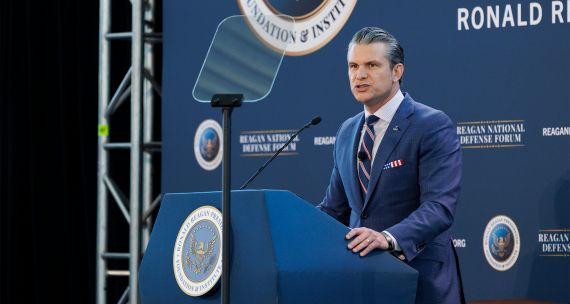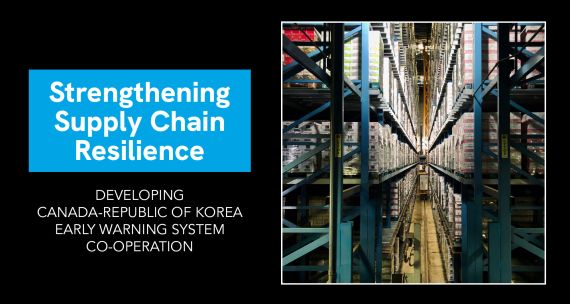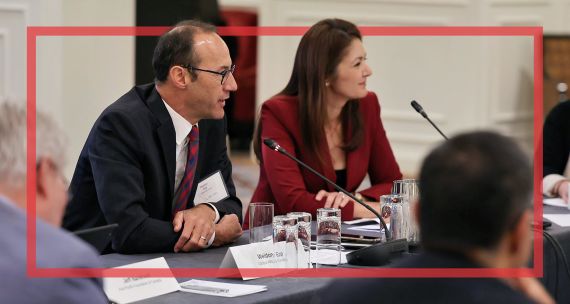The Asia Pacific Foundation of Canada held its inaugural Indo-Pacific Forum in Ottawa on October 1- 2, 2025, nearly three years after the launch of Canada’s Indo-Pacific Strategy (IPS). The Forum brought together stakeholders from the Government of Canada, academics, think-tank experts, private-sector leaders, and policy researchers from across the Indo-Pacific to assess progress and offer actionable advice on how Canada should adapt its strategy amid profound global change.
Day 1 of the Forum, held at the Fairmont Château Laurier in Ottawa, began with insights on the region’s shifting security dynamics. Day 2, held under Chatham House Rule and also at the Fairmont, focused on four major dimensions of Canada’s Indo-Pacific engagement: peace and security; trade, economic resilience, and supply chains; energy security, technology, and innovation; and development, education, and civil society collaboration. In each session, participants reviewed the IPS’s original objectives, took stock of what Canada has achieved thus far, and suggested how the strategy could be adapted to address the major disruptions to global trade and geopolitics.
Main Takeaways
- Reframe and focus the Indo-Pacific Strategy for a more contested era. Canada needs a tighter set of priority outcomes, clearer trade-offs, and explicit sequencing—moving from a long list of activities to a concise agenda that advances economic resilience and security.
- Invest in “niche strengths” that deliver outsized impact. Scale specialized capabilities such as maritime domain awareness (e.g. Dark Vessel Detection), cybersecurity capacity, counter-disinformation, disaster response, and targeted security training with key partners.
- Anchor engagement in a short list of strategic partners and minilaterals. Deepen co-operation with Japan, South Korea, the Philippines, Taiwan, Australia, Vietnam, and Indonesia, while working through ASEAN where appropriate.
Make people-to-people ties Canada’s force multiplier. Treat education, research collaboration, and civil-society connectivity as generational investments; modernize approaches to development assistance to align values with practical impact in support of economic and security objectives.
Encore Highlights Video
October 1: Public Panel on Shifting Security Dynamics in the Indo-Pacific
APF Canada President & CEO, Jeff Nankivell, and Vice-President Research & Strategy, Vina Nadjibulla, opened the Forum by observing that when Canada launched its Indo-Pacific Strategy in November 2022, the world was already undergoing a process of fundamental change. Three years later, it is facing a whole new level of disruption. For Canada to remain a safe, stable, and prosperous society, it must accept the need to do things differently, especially in its approach to foreign policy. An updated IPS will be vital to helping guide Canada through that process. Canada’s Indo-Pacific Strategy was initially conceived to be broadly aligned with the U.S.’s approach to the region. Now, it needs to be rethought in light of the widening fissure between Canada and the U.S., as well as the major departures under the Trump 2.0 administration in how the U.S. views and relates to the Indo-Pacific.
To help Canadians better understand these changes, the Forum welcomed Dr. Victor Cha, President of the Geopolitics and Foreign Policy Department and Korea Chair at the Center for Strategic and International Studies in Washington, D.C., to offer a keynote address on the evolving security landscape of the Indo-Pacific region and the Trump administration’s approach to the Indo-Pacific. Dr. Cha noted that we are witnessing the return of great power competition and a definitive move away from the strategic template that defined Washington’s China engagement for decades, namely, an effort to make China a responsible stakeholder in the international system. For allies, this has created considerable uncertainty; they can no longer hedge by looking to China for economic ties and the U.S. for security ties.
Meanwhile, there is a cohering of the world’s autocracies, especially Russia, China, Iran, and North Korea. While they are not the autocratic world’s version of the Quad, Dr. Cha explained, they are engaging in bilateral-level activity and acting in parallel with one another in a way that should concern Canada, the U.S., and our Western allies.
The U.S. and China are also weaponizing trade and finance and undermining norms vis-à-vis the use of force as a legitimate form of statecraft. This is happening as global institutions break down: the UN Security Council is gravely underperforming in responding to the world’s major crises, the WTO is unable to manage the weaponization of trade and finance, the G20 is not up to the task of exercising real global governance, and BRICS, the 10-member intergovernmental organization founded by China, India, Russia, and Brazil, despite trying to create new ‘rules for the road,’ has failed to advance a new model for the world.
The U.S. is also jettisoning its paradigmatic view of its allies; while Washington used to view U.S. allies as a net asset, it now views them more as a net liability. In contrast, adversaries are viewed as enticing targets for engagement. Similarly, Washington used to be comfortable with diffuse reciprocity from allies but now focuses on transactions and insists on specific reciprocity – that is, the U.S. does things for allies only if there is an immediate pay-off. The lens through which the Trump administration is looking at these allies has narrowed considerably; they are no longer valued for both security and non-security benefits, but measured by two metrics: the allies’ defence spending as a percentage of their GDP and the size of their trade balance with the U.S.
Finally, while there is much talk about the unpredictability of Trump 2.0 foreign policy, Dr. Cha said that, in some regards, Trump is strategically predictable but tactically unpredictable, specifically, in how he acts on those new strategic metrics.
The upshot of all of this is tremendous instability for allies. Dr. Cha described some commonalities in how U.S. allies are responding. Specifically, while many initially wished to resist, they have since tried to cut deals with the U.S. and have ultimately internalized their responsibility for preserving their long-term relationships, working directly with Washington rather than each other.
Canadian General (Rtd.) Wayne Eyre, drawing from his decades of experience and leadership of the Canadian Armed Forces, spoke about the challenges of dealing with the world’s other superpower: China. He said the IPS “got it right” in describing China as a disruptive global power increasingly aggressive in its treatment of others. He described the “unrelenting cognitive warfare” Beijing is waging in the region, especially toward Taiwan, where China is trying to sow doubt – about the reliability of Western support, the proficiency of Taiwan’s military, and whether the Taiwanese can trust their government, noting that China is attempting to accomplish the latter through disinformation campaigns, including those that micro-target segments of Taiwanese society.
General Eyre shared his assessment that Chinese President Xi Jinping remains firmly committed to uniting Taiwan with the Mainland, adding that China’s military exercises are increasingly complex, involve a greater number of forces, and appear aimed at creating confusion around the intentions and the ability to discern an exercise from an invasion. Such an invasion would be militarily difficult, the general explained, adding that Beijing is prioritizing lawfare and shifting the burden of escalation onto others. He suggested that the Second Thomas Shoal in the South China Sea, the site of an increasingly tense stand-off with the Philippines, could be the more likely place where conflict is sparked.
Canada has its own experience with Chinese military aggression, the general explained. This includes unsafe and unfriendly intercepts with its aircraft and ships, happening with growing frequency and intensity. General Eyre said Canada shares the assessment with others that these actions are meant to intimidate and communicate that our presence in the region is not welcome, although he underlined that when he speaks with regional partners, Canada is indeed a welcome presence in the Indo-Pacific.
General Eyre also noted that while Canada’s presence in the region has been normalized, including since the onset of the IPS, it has come with some costs, such as the reduction of Canada’s commitments to NATO. Canada nonetheless needs to double down on its engagement with the Indo-Pacific. And while there are limits to our capacity, he added, we can and should ensure that our engagements have a high return on investment, whether by deterring adversaries or reassuring partners. In addition to increasing investment in our defence industrial base, Canada can also do more to train with and support regional allies and partners, as it has done in the context of Russia’s war on Ukraine.
October 2: Major Dimensions of Canada’s Indo-Pacific Engagement (Closed-door Strategic Sessions)
Opening Session
The second day of the Forum opened by building on the themes introduced in Day 1, namely, that the major changes to the global system strengthen the rationale for Canada to focus on the Indo-Pacific. One participant predicted that Canada’s current five-year IPS will soon be seen as a well-timed prequel to an even more intense phase of engagement that goes well beyond our traditional North American and European geographic bases. It was also observed that there is strong alignment between the IPS and two of Prime Minister Mark Carney’s core missions: trade diversification and protecting Canadian sovereignty.
It was stressed too that implementing and translating the strategy into outcomes needs to be a ‘team sport’ involving actors beyond the federal government. It also requires making a strong case to the Canadian public that we should pay closer attention to the Indo-Pacific. The October summit meetings of the Association of Southeast Asian Nations (ASEAN) and Asia-Pacific Economic Cooperation (APEC), including the prime minister’s first official visit to the region, were a good place to start.
Session I – Peace and Security
Moderated by Vina Nadjibulla, with Ty Curran, Brent Napier, Jonathan Berkshire Miller, Vincent Rigby, Nane Baldauff, and Suon Choi as lead discussants, this first session assessed Canada’s security objectives in the IPS, its achievements and limitations over the past three years, shifting regional dynamics under the new U.S. administration, and recommendations for strengthening deterrence, resilience, and partnerships. Professor Stephanie Carvin served as the Rapporteur.
Canada’s Department of National Defence and the Canadian Armed Forces have been leaders in the frontline implementation of the IPS through an expansion of their military presence in the region, including the increase from two to three frigates deployed to promote peace and security and scaled-up Canadian participation in joint military exercises with regional partners.
Canada is also having an outsized impact through its Dark Vessel Detection (DVD) program, which uses satellite technology to identify vessels operating without proper identification in other nations’ maritime jurisdictions. This technology also aids in monitoring commercial traffic to prevent collisions, monitoring underwater critical infrastructure, and combating illegal fishing, which is rampant in parts of the region. Another example of Canada leveraging its ‘niche’ expertise to the benefit of regional partners is the deployment of eight cyber attachés across the Indo-Pacific to engage in bilateral cyber diplomacy with partners and strengthen Canada’s participation in key regional cybersecurity events.
Several Forum participants from the Indo-Pacific confirmed that Canada’s stepped-up efforts are noticed and appreciated. The DVD program has contributed meaningfully to the Philippines’ maritime domain awareness operations. Other areas of collaboration and co-operation were noted. In North Asia, Canada and Japan have institutionalized their defence relationship, including the recent signing of a bilateral agreement on sharing security information and the negotiations on an equipment and technology transfer agreement. And South Korea and Canada held their first-ever ‘2+2’ meeting between the countries’ foreign and defence ministers in 2024. Such engagement mechanisms, noted one participant, are important building blocks in a region that lacks NATO-like alliance structures.
Several suggestions were made to build on Canada’s momentum in the region:
1. Expand Canada’s contributions to niche security areas and capabilities. It will take time for Canada to develop major military capabilities; in the near term, it can be an even greater provider of non-traditional security assistance in areas such as disaster response, countering disinformation, cybersecurity, and the deployment and governance of artificial intelligence (AI).
2. Include North Pacific partners in Canada’s Arctic defence strategy. These partners view Canada as a major Arctic power. The deepening of our relationships with both Japan and South Korea, including our defence industrial co-operation with both partners, can be leveraged to that effect.
3. Increase maritime assistance to the Philippines to include expertise on information verification. This would help the country become more effective at creating a common operating picture across its maritime agencies.
4. Explore opportunities for Canada to join the growing array of regional minilateral groupings. These invitations are more likely to be forthcoming if Canada can bring something to the table. The Philippines could be an anchor partner in this respect, given that it is already a member of several trilateral and minilateral groupings.
Participants also suggested how defence and security under the IPS could be re-imagined and re-focused:
1. Anchor the IPS in a broader national security strategy. Canada has an assortment of regional strategies that need to be brought together under a coherent and co-ordinated foreign policy strategy. Policymakers in Ottawa should ensure that the IPS reflects the growing inter-connectedness between the Indo-Pacific and Euro-Atlantic security theatres. There was also a comment that Canada’s Arctic foreign policy (released in 2024) is inadequate compared to the robust Arctic strategies of several Asian states, which situate Arctic engagement within their broader geopolitical outlooks.
2. Re-assess the geographic scope of Canada’s involvement in peace and security initiatives. This assessment should weigh whether Canada would be more effective with a wide regional presence or by focusing primarily on the North Pacific.
3. Explicitly recognize the links between the security pillar and other pillars, such as trade and investment.
4. Deepen understanding of China’s disruptive influence and the extent of this disruption, including in the Indian Ocean, which one participant described as a “blind spot” for Canada.
5. Similarly, acknowledge India’s role as a linchpin of regional security. Consider whether Canada’s security presence and deployments could extend to the Indian Ocean, given the importance of that region’s maritime routes for global trade and energy security.
Session 2 – Trade, Economic Resilience & Supply Chains
Moderated by Professor Patrick Leblond, with Sara Wilshaw, Karthik Nachiappan, Jessica Shadian, Don McLain Gill, and Trevor Nieman as lead discussants, this session evaluated Canada’s trade and supply chain goals in the Indo-Pacific Strategy, took stock of achievements to date and new challenges, including U.S. tariff policies and shifting regional trade pacts, and considered policy options to advance diversification and strengthen economic resilience. Professor Ari Van Assche served as the Rapporteur.
The IPS laid out several main objectives on this set of geoeconomic issues: diversification, promoting rules-based trade, and reinforcing supply chain resilience, with an underlying goal of supporting good jobs for Canadians.
There have been several large federal government-organized trade missions to the region, one federal representative explained, and Canada has increased its physical presence; there are now Canadian trade representatives in almost every market in the region, with some markets hosting trade representatives in more than one city.
Finally, there has been noticeable progress toward new trade agreements. The recent signing of the Comprehensive Economic Partnership Agreement with Indonesia is one example, and the forthcoming free trade agreement with the Association of Southeast Asian Nations (ASEAN) is another. There have also been developments with Japan on defence co-operation and nuclear energy, including the latter’s interest in Canada’s traditional reactors and small modular reactor (SMR) technology.
Non-governmental engagement has also been robust. The Canadian Chamber of Commerce is working with various bilateral, country-level chambers of commerce in the region and is organizing smaller and more sector-specific business-led trade missions.
Several participants drew attention to long-term trends, particularly in Southeast Asia, that present opportunities for Canada, including favourable demographics, the growth of digital adoption, and a focus on climate and energy transitions.
Nevertheless, despite Canada’s growing list of achievements and the major investments made in export development support for the region, a recent survey suggests that many Canadian companies that are interested in new markets are not yet looking to the Indo-Pacific.
With these observations in mind, participants made the following recommendations:
1. Continue investing in trade facilitation infrastructure in Canada. Canadian businesses need the right kind of support and the encouragement that entering these markets is worthwhile and can be done in a de-risked way.
2. Pursue targeted agreements with like-minded countries on digital and environmental issues. While Canada’s merchandise trade with the Indo-Pacific (especially ASEAN) has grown in recent years, trade in services is lagging. New agreements could also try to align digital standards.
3. Prioritize investment. This includes in Canada’s North, where there is a significant need for investment to address infrastructure deficits. Neglecting the North will foster the conditions for instability by leaving a void that could be filled by actors seeking to make inroads in that region, including Chinese companies that have already acquired stakes in critical minerals operations.
4. Think beyond bilateral frameworks for critical minerals co-operation. Canada also needs to address co-ordination and information problems related to pricing, capital mobilization, and transparency.
Session 3 – Energy Security, Technology & Innovation
Moderated by Jeff Nankivell, with Rachel McCormick, Nadir Patel, Tuvshinzaya Gantugla, and Yujen Kuo as lead discussants, this session reviewed the IPS’s objectives in energy, technology, and innovation, assessed Canada’s progress in critical minerals, clean energy, AI, and emerging tech, considered how to adapt to global shifts in innovation and industrial policy, and proposed future priorities for collaboration and safeguarding economic security. Motria Savaryn-Roy served as the Rapporteur.
The IPS introduced several ideas for strengthening Canada’s – and our regional partners’ – energy security and supply chain resilience: developing a national trade corridor, positioning Canada as a supplier of clean energy, and expanding natural resource ties with priority Indo-Pacific partners.
Natural Resources Canada (NRCan) sits at the intersection of all these areas. Participants heard how NRCan’s focus has expanded in recent years from primarily matters of science and economics to geopolitical and security concerns. Energy and critical minerals have become central to these conversations. Canada represents an advantage for Indo-Pacific partners as it is a secure and reliable supplier of both, and, for some Indo-Pacific countries, has shorter trade routes than some of its competitors.
On clean energy adoption, there have been signs of progress across the region. For example, India is rapidly scaling its clean energy use and accelerating its deployment of solar and wind. South Korea has put hydrogen semiconductors at the heart of its industrial strategy. Japan is developing a balanced nuclear policy with renewables and new technologies, such as hydrogen hubs. And in Southeast Asia, Vietnam is becoming a manufacturing hub for electronics and renewable energy components, Indonesia is leveraging its nickel reserves for global EV supply chains, and Singapore has established itself as a leader in fintech and digital innovation.
What has Canada done under the IPS to take advantage of these opportunities? NRCan has beefed up its in-market presence in Japan and South Korea, built departmental capacity to understand regional opportunities, and facilitated the first shipments of LNG from Canada’s West Coast to Asia. In addition, the completion of the TMX pipeline in 2024 has facilitated Canadian oil exports to Asian partners. There has also been progress domestically on batteries and mechanisms for Canada to work with Indo-Pacific countries on technologies such as carbon capture, nuclear energy, and wind power.
One participant noted that energy security and technological innovation are no longer separate silos but are converging and increasingly integrated. Clean energy transitions require not only new fuels but also digital infrastructure, advanced materials, and data-driven efficiency to make energy systems reliable and affordable. It is at this intersection where Canada’s strengths can have an outsized impact.
With that overview, participants advanced the following ideas for the next phase of Canada’s IPS:
1. Focus more on areas where supply chains, innovation, and strategic competition converge. This could include expanding the financial toolkit for Canadian companies, including export finance, credit guarantees, and partner ventures.
2. Transition from one-off projects to longer-term and more structured partnerships, recognizing that no single country can handle large projects around critical minerals or nuclear energy, nor can a single country reasonably finance an entire project. Ideas for such partnerships include a Canada-India clean energy finance corridor or a Canada-South Korea pilot project on hydrogen and advanced materials.
3. Limit the number of minerals designated as “critical.” Canada currently lists 47 elements as “critical,” making it difficult to sharpen its policy focus in this area. Additionally, there is a need to address market failures for elements that have very little demand per user. Canada could consider developing tools in partnership with the G7 and other partners to manage demand, including through joint stockpiling initiatives.
Session 4 – Development, Education & Civil Society Collaboration
Moderated by Professor Victor Ramraj, with Sanjay Ruparelia, Bart Edes, Aries Arugay, and Rohinton Medhora as lead discussants, this program focused on reviewing Canada’s development assistance, education and research collaboration, and people-to-people ties, making note of the changing landscape on development assistance and U.S. role in the region and identifying future priorities for Canada’s programming, funding, and partnerships in the Indo-Pacific. David McKinnon was The Rapporteur.
The IPS made several commitments in this area, including expanding educational exchanges, empowering civil society organizations, promoting Canada’s Feminist International Assistance Policy, supporting sustainability in the region, bolstering visa-processing capacity, and enhancing skills development and human rights initiatives.
While much of the Forum’s discussion was focused on government-to-government ties, the IPS is framed as a whole-of-society effort, suggesting that Canadian higher education institutions, civil society organizations, and other actors have important roles to play, as do First Nations, Inuit, and Metis communities. The IPS’s success will ultimately rest on the strength of people-to-people ties. Investing in these ties and the ‘Asia competence’ of Canadians needs to be a generational commitment. Some participants observed that although Canada is multicultural in its makeup, it is not always international in its outlook. Similarly, Canada is a Pacific nation but still thinks primarily in Atlantic rather than Pacific terms.
Regarding international development assistance, the rapidly changing global landscape, not least of all the dramatic scaling back of U.S. development assistance, has made it imperative for Canada to reflect on its priorities in the region. One of the lead discussants noted that, according to the latest OECD report, Canada is the sixth-largest provider of overseas development assistance (ODA), but only a small percentage of this aid is allocated to Asia. Another participant stressed that continuing to focus on supporting human rights, gender equality, and climate resilience is essential even in the face of many other partners scaling back their support in these areas.
In light of these considerations, it was noted that Canada should:
1. Take a leadership role in shaping a new global paradigm for international development. If Canada were to cut its development assistance to the Indo-Pacific, it would diminish our influence in the region, especially at a time when other development partners – including, but not limited to, the U.S. – are cutting their spending. While Canada alone can’t fill the development gap, it can forge partnerships, including with new, non-Western donors, scale up its operations with regional development banks, and find ways to leverage its membership in international organizations. In addition, it was noted that Canada should review how much of its development assistance goes directly to civil society organizations in recipient countries.
As part of this discussion, some participants cautioned against subordinating Canada’s development assistance to other foreign policy goals, including trade. On a similar note, another participant explained that in the 2010s, Canada’s development assistance agency was folded into a ‘super’ department that oversaw foreign affairs and trade. The effect was a downgrading of the prominence and utility of Canadian development assistance in the Indo-Pacific.
2. Continue support for women and girls, but in quieter ways. One participant pointed out that there is a big opportunity to invest in girls’ education – something that has many positive and long-term ramifications, including raising a country’s GDP over the long term. But these priorities need to be presented in a way that does not come across as moralizing or suggest that Canada has all the answers.
3. Canada should also leverage its leadership on The Women, Peace, and Security Agenda. Several participants from the region affirmed that this UN-led global initiative was perceived positively in the region.
4. Gain a more updated and nuanced understanding of Canada’s Indo-Pacific diaspora populations. The Indian and Chinese diasporas are large and growing, and their composition is changing in ways many Canadians and Canadian companies and organizations still do not fully understand, including the socio-economic profile of new Indian immigrants.
5. Take a whole-of-country approach to raising the profiles of Canadian universities in the region.
6. Develop greater policy coherence across these areas. Canada would benefit from a soft power strategy linked to hard power issues. There could also be joint efforts around soft power projection by Canada and its partners in the region.






